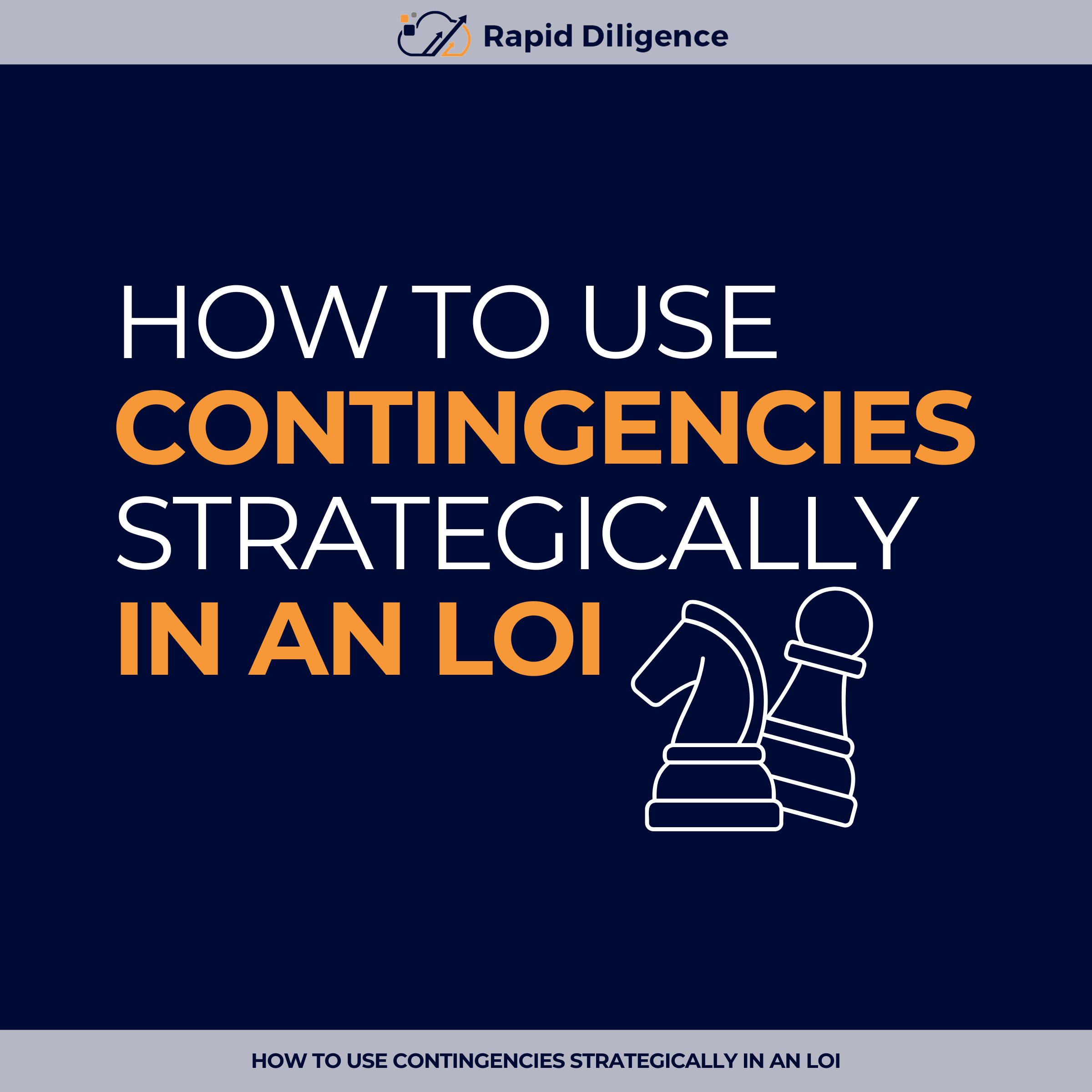In small business acquisitions, the Letter of Intent (LOI) sets the stage for everything that follows. While it is typically non-binding, it outlines the buyer’s intent, proposed terms, and conditions for moving forward.
One of the most powerful tools within an LOI is the contingency clause. Contingencies protect you as a buyer by making the deal conditional on certain events or findings. Used well, they can safeguard your interests, uncover critical information, and keep you from committing to a bad acquisition.
Used poorly, they can slow the deal down or make you seem like an overly cautious buyer in a competitive process.
This article will explain how contingencies work in LOIs, the most common types you should know, and how to use them strategically to secure the right deal.
What Are Contingencies in an LOI?
A contingency in an LOI is a condition that must be satisfied before you proceed to closing. They are designed to give the buyer the opportunity to validate their assumptions about the business before finalizing the purchase.
For example, you might agree to buy a company for $2.5M, but only if your due diligence confirms that the reported revenue and profit are accurate, the key customer contracts are transferable, and you can secure financing on acceptable terms.
If these conditions are not met, you have the right to renegotiate or walk away without penalty.
Why Contingencies Matter for Buyers
Contingencies serve several important purposes:
- Risk Mitigation
They allow you to verify the accuracy of financials, operations, and legal standing before being fully committed. - Negotiation Leverage
If due diligence reveals issues, contingencies give you a basis for requesting changes to the price or terms. - Financing Protection
If your deal depends on lender approval, a financing contingency ensures you are not stuck if funding falls through. - Clarity in the Process
Contingencies set expectations for what needs to happen before closing, keeping both sides aligned.
Without them, you risk losing your deposit or being pressured to close even when material issues surface.
Common Contingencies in Small Business LOIs
While contingencies can be customized to the deal, several types are frequently included in small business acquisitions.
1. Due Diligence Contingency
The most common contingency. The buyer’s obligation to close is dependent on the satisfactory completion of due diligence, which can include financial, operational, legal, and commercial reviews.
This contingency should clearly define:
- The scope of due diligence (financial records, tax filings, contracts, etc.)
- The time allowed for completion
- The buyer’s right to withdraw or renegotiate if findings are unsatisfactory
2. Financing Contingency
Protects the buyer if they cannot secure financing on agreed-upon terms. This is especially important for acquisition entrepreneurs who rely on SBA loans, investor equity, or seller financing.
A financing contingency typically includes:
- The type of financing sought
- Deadlines for securing approval
- The buyer’s right to exit if financing is unavailable
3. Third-Party Consent Contingency
Some deals require approval from landlords, franchisors, key customers, or suppliers. If these consents cannot be obtained, the business may not be transferable in its current form.
The contingency should state:
- Which consents are required
- Who is responsible for obtaining them
- The timeline for doing so
4. Regulatory or Licensing Contingency
In certain industries, licenses or regulatory approvals must be transferred or reissued to the buyer. If this process cannot be completed, the deal may collapse.
This is common in sectors such as healthcare, childcare, and transportation.
5. Material Adverse Change (MAC) Contingency
Protects the buyer if there is a significant negative change in the business before closing. This could include the loss of a major customer, a lawsuit, or a drastic decline in revenue.
6. Seller Transition and Training Contingency
If your deal includes a post-close transition period, you can make the closing contingent on the seller agreeing to a defined training and handover plan.
How to Use Contingencies Strategically
Contingencies are not just about protection. How you structure and communicate them can impact how the seller perceives you as a buyer.
Here are some strategies for using contingencies effectively.
Be Specific and Measurable
Avoid vague language like “subject to satisfactory due diligence.” Instead, outline exactly what areas will be reviewed and what constitutes “satisfactory.” The more clarity you provide, the less room there is for disputes.
Prioritize the Most Critical Risks
While it can be tempting to include every possible contingency, too many conditions can make you appear hesitant or inexperienced. Focus on the deal-breaking items and leave minor issues for the negotiation phase.
Set Clear Timelines
Give yourself enough time to complete the necessary work, but avoid overly long contingency periods that could cause the seller to lose interest or entertain other offers. A defined 30- to 60-day diligence window is common.
Use Contingencies as Negotiation Tools
If an issue is discovered, contingencies give you a framework to renegotiate without appearing arbitrary. For example:
- Lowering the purchase price to reflect uncovered liabilities
- Requesting an escrow holdback for unresolved risks
- Extending the training period to address operational gaps
Match the Contingencies to the Deal Context
In a competitive process, too many contingencies can weaken your offer compared to other buyers. In this case, keep them focused on the absolute essentials, and show the seller you are committed to moving quickly once they are satisfied.
In less competitive situations, you may have more room to include additional protections.
Common Mistakes to Avoid
When using contingencies, watch out for these pitfalls:
- Overloading the LOI with minor contingencies that slow the deal and signal a lack of confidence.
- Using vague or open-ended language that invites disputes later.
- Failing to set deadlines for each condition, leading to stalled momentum.
- Not understanding the seller’s perspective, which can make them defensive or less cooperative.
Balancing Protection and Competitiveness
The art of using contingencies lies in balancing your need for protection with the seller’s desire for certainty. The right structure keeps you safe without giving the impression you are looking for excuses to walk away.
In practical terms:
- Include the protections you truly need.
- Present them as standard and reasonable.
- Make it clear that you are motivated to close if the conditions are met.
This approach positions you as both a serious and professional buyer.
Final Thoughts
A well-written LOI with carefully chosen contingencies is one of the most important tools in an acquisition entrepreneur’s toolkit. It sets expectations, mitigates risk, and ensures that you only close on a deal that meets your requirements.
The key is to use contingencies strategically, not as a catch-all for every possible concern. Focus on the conditions that truly matter to the success of your acquisition, and make sure they are clear, measurable, and time-bound.
If you do, you’ll protect yourself while still presenting a strong, competitive offer, and that balance can be the difference between winning the right deal and walking away from the wrong one.
Contact us today or book a free consultation and learn how we can be a trusted partner on your next deal!







